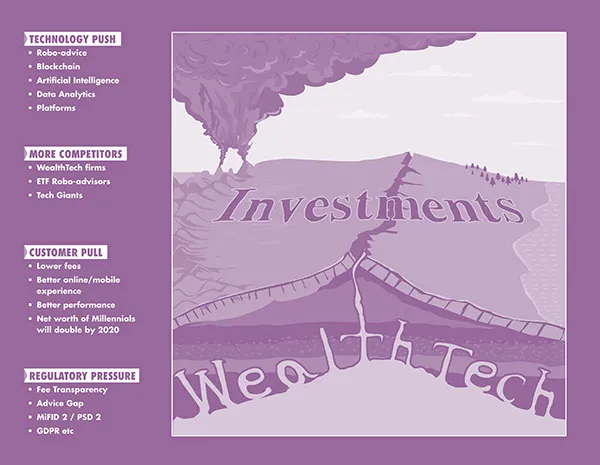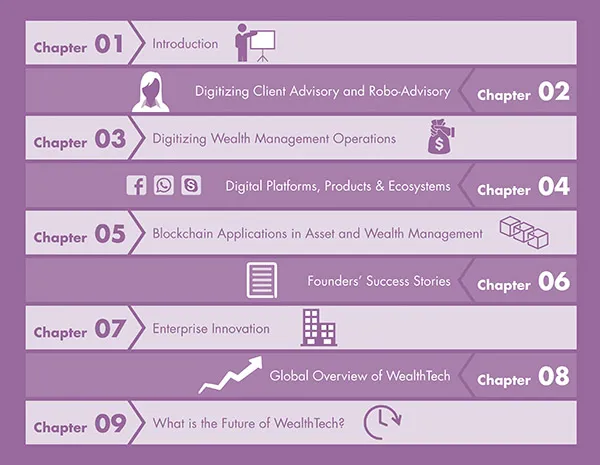Since we are currently experiencing the fourth industrial revolution, we should not be surprised that wealth management is entering a fourth epoch as well. What is particularly exciting about this era is that it offers an opportunity to fundamentally rethink the business of wealth management, rather than simply providing a more efficient replication of what went before.
A brief reminder – the World Economic Forum has defined the four industrial revolutions as: the rise of mechanical power; the advent of electricity and communications; the digital age and the development of modern computing; and finally a new era that builds and extends the impact of digitization in new and unanticipated ways.
The four stages of wealth management are slightly out of step with these. Technological advances have been a constant in the financial services industry, as investors have sought to find the most efficient and effective means of putting capital to work, but we can also discern significant step-changes in the way wealth management was conducted.
The first three epochs of wealth management were, broadly speaking: the hand delivery of documentation; the mechanization of those hand-to-hand processes; and the development of computing solutions.
That first involved the old coffee-house method of investment, where company documents were handwritten and exchanged among patrons. This developed into the old stock exchange trading floor, complete with jobbers and runners to distribute the news. Paul Julius Reuter opened his first office just behind the Royal Exchange in London (it still stands today). The boys he employed to carry news back and forth between the trading floor and his offices were perhaps the first low-latency trading solution.
The second stage was the laying of telegraphic cables across the world, and the use of ticker-tape machines to send information across huge distances. Again, pioneers such as Reuter effectively shrunk the world, providing a new richness and depth of information for investors.
The third era came in the 1960s, when computer networks began replacing the ticker-tape machines and systems such as ILX and Quottron were developed, providing processing power at speed and gathering information from price sources around the world. In the 1990s the internet and the rise of the home computer was followed by the development of online retail brokerage systems, but perhaps more significantly democratized access to data about companies and other investment opportunities. A lot of the information previously prized by wealth managers as sources of insight was now available to the investing public at the click of a mouse.
As wealth management progressed through its various eras, the value proposition also changed. At first, just having a stock price or news was valuable in and of itself. Then, the value came from having information faster. Once data (such as stock prices) became more of a commodity, value was created by analysing the data or combining it with other information such as news or earnings, quickly acting on the analysis.
We are now entering a new era, a fourth epoch, driven by technological advances such as cognitive computing. Whereas the previous eras developed efficiencies in an established process, the technologies available or in development today enable us fundamentally to rethink the process. Rather than simply replicating the established methods of managing wealth, they offer an opportunity to augment these in new ways.
We are at a point where advances in computing power and lower computing costs enable us to apply artificial intelligence, machine learning, natural language processing, neural networks and a host of other tools to everyday tasks. The opportunities for wealth management are genuinely epoch-making.
Clients are Changing
The practice of wealth management basically involves finding ways to protect and build wealth in order to pass it down the generations. As this wealth grows, and as clients’ family trees grow new branches, the number of clients expands exponentially.
The average US investor is in his/her early 60s and that is likely to rise to over 70 within the next few years. More than half of assets managed (53%) are already held by clients who are over the age of 65, “leaving us poised on the precipice of the greatest wealth transfer in history”, as The Fountain of Growth puts it.1
Meanwhile, the average advisor is in his or her early 50s, with a quarter of advisors already at the typical retirement age. These advisors control 25% of assets. This is therefore a second aspect to generational wealth transfer. Both represent risks to wealth management firms.
First, assets will flow from parents to their children. In this case, wealth management firms need to position themselves to keep these assets in-house. The challenge is in addressing the “my father’s advisor” syndrome, in which a son or daughter feels that their parents’ advisor is out of touch with their views on investing, risk tolerance, how they choose to invest and how they prefer to communicate.
Second, for advisors the risk is that, without proper succession planning, customers m...


